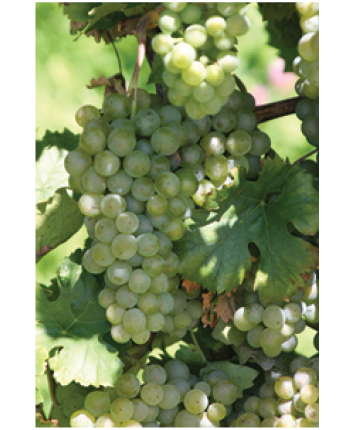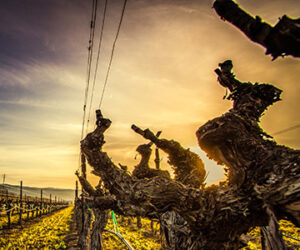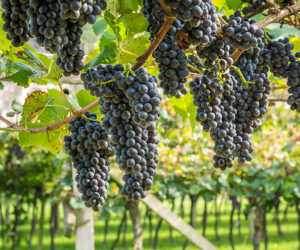 For my 50th birthday some years back, my wife and I decided to take a trip to Germany. It was December, and I will admit it is cold in December there, but we had heard so much about the outdoor Christmas markets, and we had had a rough year and like a Southwest Airlines commercial, we just “needed to get away.” We really didn’t have any wine-related items planned other than I was curious about Hochschule Geisenheim University, located in the heart of the Rheingau wine-growing region of central Germany. My curiosity was warranted in that just about every year at University of California, Davis, we receive visiting scholars from there and I was curious about their academic and research programs. The caliber of the visiting students is very high, so perhaps I could learn a thing or two about other world-class universities. The head of the Department for Enology and Wine Technology greeted us. In addition to her chairperson’s role, she is also the director of the Estate Winery at the Geisenheim Research Institute. Her first order of business was to recommend a lunch spot so we could talk and get to know a little about each other as well as get some history on the viticulture and enology program there.
For my 50th birthday some years back, my wife and I decided to take a trip to Germany. It was December, and I will admit it is cold in December there, but we had heard so much about the outdoor Christmas markets, and we had had a rough year and like a Southwest Airlines commercial, we just “needed to get away.” We really didn’t have any wine-related items planned other than I was curious about Hochschule Geisenheim University, located in the heart of the Rheingau wine-growing region of central Germany. My curiosity was warranted in that just about every year at University of California, Davis, we receive visiting scholars from there and I was curious about their academic and research programs. The caliber of the visiting students is very high, so perhaps I could learn a thing or two about other world-class universities. The head of the Department for Enology and Wine Technology greeted us. In addition to her chairperson’s role, she is also the director of the Estate Winery at the Geisenheim Research Institute. Her first order of business was to recommend a lunch spot so we could talk and get to know a little about each other as well as get some history on the viticulture and enology program there.
Geisenheim University was founded in 1872 as the Royal Prussian Institute of Pomology and Viticulture. In modern times it hosts highly regarded programs in viticulture, enology, beverage technology and wine business. Getting to the basis of this story, in 1876, Professor Hermann Müller joined the faculty at Geisenheim. Dr. Müller was the first head of the plant physiology research program. Prof. Müller was a grape breeder whose work was described as being far ahead of its time. He referred to himself as ‘Müller-Thurgau’, as he took on the name of his home canton (state) in northeast Switzerland.
The grape he bred in 1882 was his namesake Müller-Thurgau, a white grape. The nature of this article brings up some issues on the origins of certain varieties. Origins of varieties range from accidental crosses in the wild habitats, anecdotal crosses that were thought to “be the case,” to specific and deliberate cross-pollinations by grape breeders, both expert and hobbyists. The records of such breeding programs are meticulously kept. What intrigued me most about this selection was how it was listed in my “go to” listing of wine varieties and origins; Vitis International (http://www.vivc.de/index.php).
In the aforementioned listing, Müller-Thurgau is listed as a cross between Riesling Weiss and Sylvaner Gruen, you will see this also listed as Riesling x Sylvaner in the older literature. Interesting to note, this is the cross that was reported by Dr. Müller as is indicated by the phrase, “Pedigree as given by breeder/bibliography.” This particular cross, because of its popularity, was subject to further scrutiny in modern times. Subsequently, genetic marker testing of this variety indicated that it was not Sylvaner as the second pedigree, but Madeleine Royale. Madeleine Royale is a Vitis vinifera species with characteristics of early ripening, similar to Sylvaner.
What I do not know, and I could not find traceable evidence to the fact, is why Dr. Müller thought he was crossing Riesling with Sylvaner. Breedingis a complex process, and there are many thousands of seeds and subsequently seedlings produced in such a program. Presumably something got mixed up along the way with the breeding blocks themselves.
In any case, the purpose of the cross was to obtain a highly aromatic grape that ripened earlier than Riesling. The aromatic compounds are mostly terpenes, derived from its Riesling parentage. The monoterpenols have scents of flowers and hints of Muscat-like characters. To a lesser extent, it has some thiols, or sulfur-containing compounds, which offer some vegetal characters, as well as elderflowers, passion fruit and grapefruit. Preservation of these positive attributes in the fruit is essential in the winemaking process so as not to promote any bitterness in the finished wine.
I had the pleasure to talk to a new colleague about Müller-Thurgau and this balance that needs to be attained. The variety is prone to high levels of hexanal and hexanol, formed by the oxidation of fatty acids as the juice is being prepared for fermentation. Hexanol and hexanal are herbaceous in nature, are responsible for the smell of freshly cut grass, and can be bitter. To reduce this oxidation process, she carries out a very strict inert gas blanketing of the must and juice during pre-fermentation fruit processing. Dry ice is usually the choice because as it is depleted you can see that the CO2 gas is not being produced and more can simply be added as necessary. The reductive nature of the processing minimizes the oxidation process and the threat of the bitter flavors overwhelming the positive characters of the terpenes.
The best examples of Müller-Thurgau are found in cooler climates, which is one of the reasons it is, or rather was, so popular in Germany. At the high Northern latitudes, it grew in a variety of soils, produced abundant fruit, and contributed to the relatively inexpensive sweet wines of Germany. Vineyard area in 1973 was reported at 20,832 hectare (ha) (~51,500 acres), peaking at 24,405 ha (60,000 acres) in 1993. More recently, in 2012, only 13,108 ha (32,000 acres) were reported — just about half of the Riesling that is being produced in Germany, and only 12.8% of the total wine production in Germany. Incidentally, this is about the same as Spätburgunder (Pinot Noir) and Riesling takes top billing at 22.4% of all the German viticulture areas.
As is the case with any successful variety, it becomes “discovered,” and starts to migrate out of its home range. Very little Müller-Thurgau went to France, not surprising. In 1968, 58 ha (143 acres) were reported and only 5 ha (12 acres) in 2004. Hungary reports about 8,000 ha (20,000 acres), and about 5,000 ha (12,000 acres) are reported to grow in Austria. This variety also found success in Northern Italy, specifically in Trentino and the Alto Adige. My colleague, who lived in Trento for five years and has extensive experience with it, happily proclaimed, “Müller is so fun” when she found out I was writing about it. In Trentino, there are 900 ha (2,200 acres), and the Alto Adige was last reported to grow 219 ha (540 acres). The area seems small compared to the German area, but this is the Italian Alps, so the variety occupies a lot of the cultivated land. In this area, elevations between 500-700 meters produce excellent examples of Müller-Thurgau. It does grow at lower elevations in these areas, e.g. in the valleys, but the quality is not as good. It is a very popular variety in the region, and is enjoyed in the bars and restaurants as the local, homegrown variety that is light and refreshing with a nice sapidity.
Outside of Europe, Müller-Thurgau is not grown in California, at least not being significant enough to make the grape crush report. To the north, in Oregon, 80 acres were reported in 2011 spread out in the Willamette Valley, Dundee Hills, and the Yamhill-Carlton district. Perhaps some of you were able to taste it on your recent trip to Portland at the 2015 Wine-Maker Magazine Conference. Further north, it is also planted in British Columbia, but is not a major planting in the region.
Worldwide, the University of Adelaide reports that in 2010 there were 22,753 ha (56,000 acres) of Müller-Thurgau planted, which ranks it as the world’s 37th most popular wine grape.
Back in Geisenheim, we proceeded to the restaurant at Schloss Johannisberg, famous for its role in the establishment of “spätlese” styles in German wine history. Schloss Johannisberg was originally established as an abbey almost 1,200 years ago. In World War II, an “emergency bomb drop” destroyed the property. Its owners eventually rebuilt the buildings by 1965. Our lunch was a traditional German fare of meat and potato-based dishes. The wine was wonderful, although I do not recall what we had. I do recall later that afternoon we tasted the Müller-Thurgau produced at the university winery, vintage 2008. Coincidentally, from our window-front table in the restaurant, we saw a marker on the hillside in the vineyard below. Our hostess pointedly remarked that it identified the latitude of 50 degrees north. How fitting!
Special thanks to my colleague, Melissa Pellini for sharing her expertise with this variety.
Müller-Thurgau Recipe (5 gallon/19 L)
Ingredients
100 lbs. (45 kg) Müller-Thurgau grapes
~20 mL distilled water
10% potassium metabisulfite (KMBS) solution. Weigh 10 grams of KMBS, dissolve into about 75 milliliters (mL) of distilled water. When completely dissolved, make up to 100 mL total with distilled water.
5 grams Zymaflor VL3, Anchor VIN13, or Lallemand QA23 yeast
5 grams Fermaid K (or equivalent yeast nutrient)
5 grams Di-ammonium Phosphate (DAP)
Rice hulls
~3 lbs. (1.4 kg) dry ice
Other equipment or needs
Destemmer-crusher
Basket press
18-gallon (68-L) food-grade plastic tub
5-gallon (19-L) carboy
6-gallon (23-L) carboy
6-gallon (23-L) plastic bucket
Airlock
Racking hoses
Equipment cleaning and sanitizing agents (Bio-Clean, Bio-San)
Inert gas (nitrogen, argon, or carbon dioxide)
Refrigerator (~45 °F/7 °C) to cold settle the juice. (Remove the shelves so that the bucket will fit.)
Ability to maintain a fermentation temperature of 55 °F (13 °C).
Thermometer capable of measuring between 40–110 °F (4–43 °C) in one degree increments.
Pipettes with the ability to add in increments of 1 mL.
Step by Step
1. Crush the grapes to the large tub. Place dry ice chucks into the tub. You want to see visible gassing, viewed as smoke, bubbling from the must.
2. Measure the volume of the must and mix in the rice hulls. You will need about 30% of the total volume. Do not delay between crushing and pressing.
3. Move the must/rice hull slurry directly to the press and press to the 6-gallon (23-L) bucket. Again, place the dry ice chunks into the bucket. The rice hulls aid in pressing by creating juice channels. Your juice yields will increase significantly with their use.
4. While pressing the juice to a 6-gallon (23-L) bucket, add 16 mL of 10% KMBS solution (this addition is the equivalent of 40 mg/L (ppm) SO2). Move the juice to the refrigerator.
5. Let the juice settle at least overnight. Layer the headspace with inert gas or dry ice and keep covered.
6. When sufficiently settled, rack the juice off of the sediments into the 6-gallon (23-L) carboy.
7. Prepare yeast. Heat 50 mL water to 104 °F (42 °C). Sprinkle the yeast on the surface of the water and gently mix so that no clumps exist. Let sit for 15 minutes undisturbed. Measure the temperature of the yeast suspension. Measure the temperature of the juice. You do not want to add the yeast to your cool juice if the difference in temperature of the yeast and must exceeds 15°F (8 °C). To avoid temperature shock, acclimate your yeast by taking about 10 mL of the juice and adding it to the yeast suspension. Wait 15 minutes and measure the temperature again. Do this until you are within the specified temperature range. Do not let the yeast sit in the original water suspension for longer than 20 minutes. When the yeast is ready, add it to the fermenter and stir thoroughly.
8. Add Fermaid K or equivalent yeast nutrient.
9. Initiate the fermentation at room temperature ~(65-68 °F/18–20 °C) and once fermentation is noticed (~24 hours), move to a location where the temperature can be maintained at 55 °F (13 °C).
10. About two days after fermentation starts (or when 1⁄3 of the Brix is depleted), dissolve the DAP in as little distilled water required to completely go into solution (usually ~20 mL). Add directly to the carboy and stir thoroughly.
11. Normally you would monitor the progress of the fermentation by measuring the Brix. One of the biggest problems with making white wine at home is maintaining a clean fermentation. Entering the carboy to measure the sugar is a prime way to infect the fermentation with undesirable microbes. So at this point, the presence of noticeable fermentation is good enough.
12. Leave alone until bubbles in the airlock are about one per minute. Usually about two to three weeks.
13. Measure the Brix. The wine is considered dry, or nearly dry, when the Brix reaches -1.5 °Brix or less.
14. When the fermentation is complete, add 3 mL of fresh KMBS (10%) solution per gallon (3.8 L) of wine.
15. Transfer the wine off of the lees to the 5-gallon (19-L) carboy and lower the temperature to 38–40 °F (3–4 °C). Make sure there is no headspace. Fill the 5-gallon (19-L) carboy to the top.
16. After 2–4 weeks, test for pH and SO2 adjust as necessary to attain 0.8 ppm molecular SO2. (There is a simple SO2 calculator at www.winemakermag.com/sulfitecalculator). Check the SO2 in another two weeks, prior to the next racking and adjust while racking. HINT: Rack to another sanitized 5-gallon (19-L) carboy, or your bucket. In the case of the latter, clean the original carboy and transfer the wine back to it. This is done about 4–6 weeks after the first SO2 addition. Once the free SO2 is adjusted, maintain at the target level by monitoring every 3–4 weeks.
17. Fine or filter if needed.
18. At about three months you are ready to bottle. Maintain sanitary conditions while bottling. Once bottled, periodically check your work by enjoying a bottle with friends.







